Ethanol Production from Waste Newsprint using Saccharomyces cerevisiae KNU5377
VerifiedAdded on 2019/12/28
|12
|4206
|265
Literature Review
AI Summary
Ethanol production from waste newsprint was achieved through simultaneous saccharification and fermentation using Saccharomyces cerevisiae KNU5377. The process involves breaking down cellulose in newsprint into glucose, which is then fermented into ethanol.
Contribute Materials
Your contribution can guide someone’s learning journey. Share your
documents today.

Life Cycle
Assessment Module
1
Assessment Module
1
Secure Best Marks with AI Grader
Need help grading? Try our AI Grader for instant feedback on your assignments.
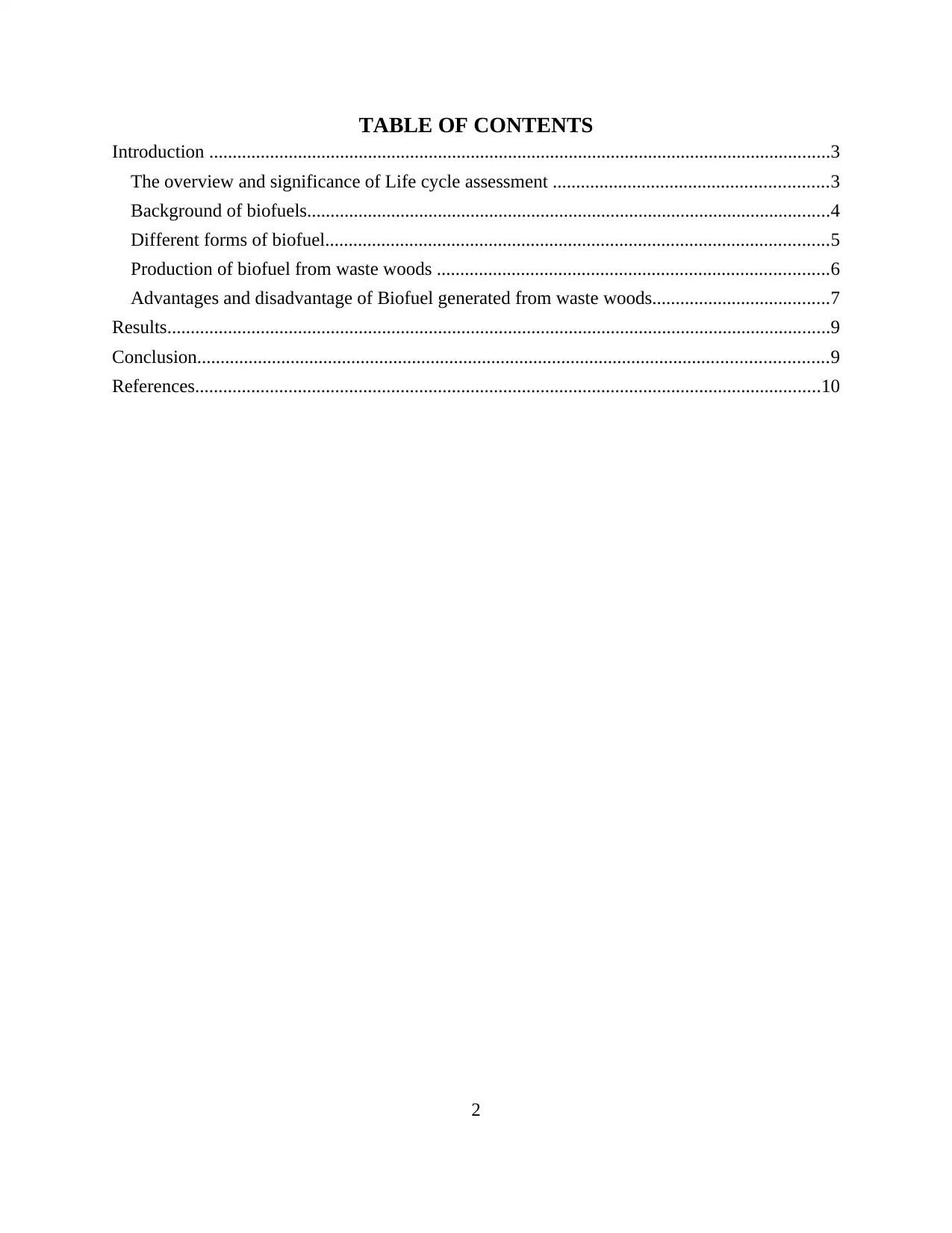
TABLE OF CONTENTS
Introduction .....................................................................................................................................3
The overview and significance of Life cycle assessment ...........................................................3
Background of biofuels................................................................................................................4
Different forms of biofuel............................................................................................................5
Production of biofuel from waste woods ....................................................................................6
Advantages and disadvantage of Biofuel generated from waste woods......................................7
Results..............................................................................................................................................9
Conclusion.......................................................................................................................................9
References......................................................................................................................................10
2
Introduction .....................................................................................................................................3
The overview and significance of Life cycle assessment ...........................................................3
Background of biofuels................................................................................................................4
Different forms of biofuel............................................................................................................5
Production of biofuel from waste woods ....................................................................................6
Advantages and disadvantage of Biofuel generated from waste woods......................................7
Results..............................................................................................................................................9
Conclusion.......................................................................................................................................9
References......................................................................................................................................10
2
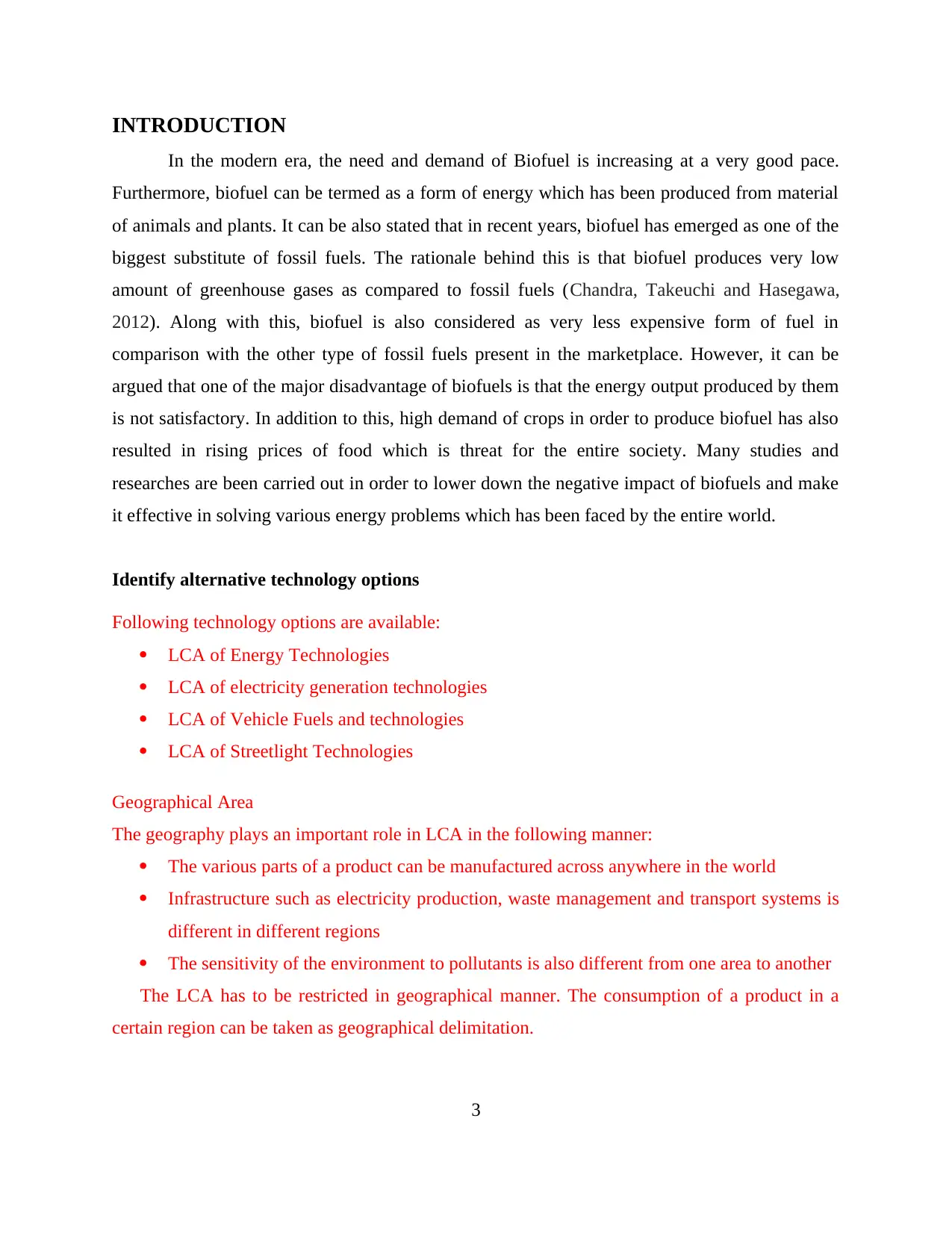
INTRODUCTION
In the modern era, the need and demand of Biofuel is increasing at a very good pace.
Furthermore, biofuel can be termed as a form of energy which has been produced from material
of animals and plants. It can be also stated that in recent years, biofuel has emerged as one of the
biggest substitute of fossil fuels. The rationale behind this is that biofuel produces very low
amount of greenhouse gases as compared to fossil fuels (Chandra, Takeuchi and Hasegawa,
2012). Along with this, biofuel is also considered as very less expensive form of fuel in
comparison with the other type of fossil fuels present in the marketplace. However, it can be
argued that one of the major disadvantage of biofuels is that the energy output produced by them
is not satisfactory. In addition to this, high demand of crops in order to produce biofuel has also
resulted in rising prices of food which is threat for the entire society. Many studies and
researches are been carried out in order to lower down the negative impact of biofuels and make
it effective in solving various energy problems which has been faced by the entire world.
Identify alternative technology options
Following technology options are available:
LCA of Energy Technologies
LCA of electricity generation technologies
LCA of Vehicle Fuels and technologies
LCA of Streetlight Technologies
Geographical Area
The geography plays an important role in LCA in the following manner:
The various parts of a product can be manufactured across anywhere in the world
Infrastructure such as electricity production, waste management and transport systems is
different in different regions
The sensitivity of the environment to pollutants is also different from one area to another
The LCA has to be restricted in geographical manner. The consumption of a product in a
certain region can be taken as geographical delimitation.
3
In the modern era, the need and demand of Biofuel is increasing at a very good pace.
Furthermore, biofuel can be termed as a form of energy which has been produced from material
of animals and plants. It can be also stated that in recent years, biofuel has emerged as one of the
biggest substitute of fossil fuels. The rationale behind this is that biofuel produces very low
amount of greenhouse gases as compared to fossil fuels (Chandra, Takeuchi and Hasegawa,
2012). Along with this, biofuel is also considered as very less expensive form of fuel in
comparison with the other type of fossil fuels present in the marketplace. However, it can be
argued that one of the major disadvantage of biofuels is that the energy output produced by them
is not satisfactory. In addition to this, high demand of crops in order to produce biofuel has also
resulted in rising prices of food which is threat for the entire society. Many studies and
researches are been carried out in order to lower down the negative impact of biofuels and make
it effective in solving various energy problems which has been faced by the entire world.
Identify alternative technology options
Following technology options are available:
LCA of Energy Technologies
LCA of electricity generation technologies
LCA of Vehicle Fuels and technologies
LCA of Streetlight Technologies
Geographical Area
The geography plays an important role in LCA in the following manner:
The various parts of a product can be manufactured across anywhere in the world
Infrastructure such as electricity production, waste management and transport systems is
different in different regions
The sensitivity of the environment to pollutants is also different from one area to another
The LCA has to be restricted in geographical manner. The consumption of a product in a
certain region can be taken as geographical delimitation.
3
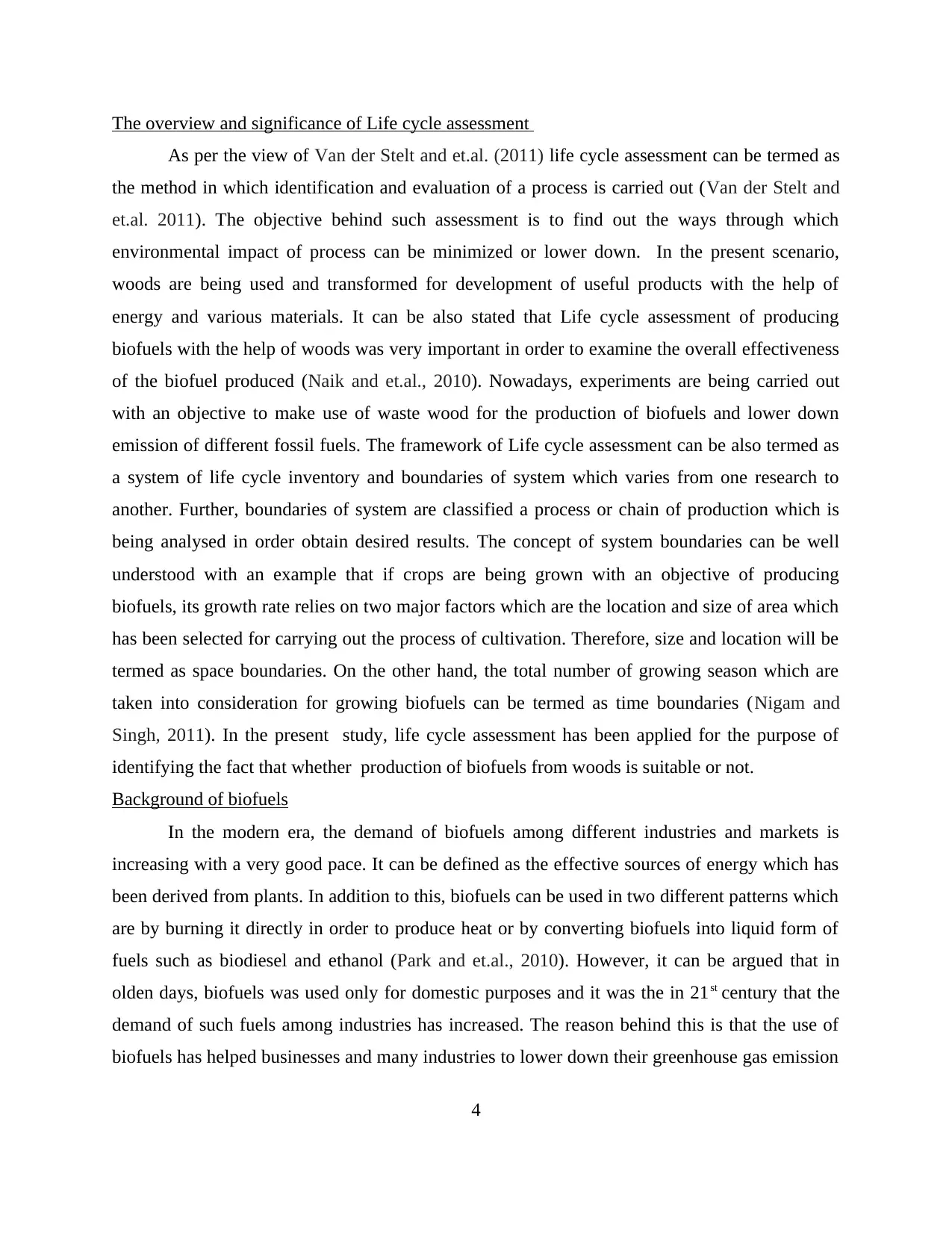
The overview and significance of Life cycle assessment
As per the view of Van der Stelt and et.al. (2011) life cycle assessment can be termed as
the method in which identification and evaluation of a process is carried out (Van der Stelt and
et.al. 2011). The objective behind such assessment is to find out the ways through which
environmental impact of process can be minimized or lower down. In the present scenario,
woods are being used and transformed for development of useful products with the help of
energy and various materials. It can be also stated that Life cycle assessment of producing
biofuels with the help of woods was very important in order to examine the overall effectiveness
of the biofuel produced (Naik and et.al., 2010). Nowadays, experiments are being carried out
with an objective to make use of waste wood for the production of biofuels and lower down
emission of different fossil fuels. The framework of Life cycle assessment can be also termed as
a system of life cycle inventory and boundaries of system which varies from one research to
another. Further, boundaries of system are classified a process or chain of production which is
being analysed in order obtain desired results. The concept of system boundaries can be well
understood with an example that if crops are being grown with an objective of producing
biofuels, its growth rate relies on two major factors which are the location and size of area which
has been selected for carrying out the process of cultivation. Therefore, size and location will be
termed as space boundaries. On the other hand, the total number of growing season which are
taken into consideration for growing biofuels can be termed as time boundaries (Nigam and
Singh, 2011). In the present study, life cycle assessment has been applied for the purpose of
identifying the fact that whether production of biofuels from woods is suitable or not.
Background of biofuels
In the modern era, the demand of biofuels among different industries and markets is
increasing with a very good pace. It can be defined as the effective sources of energy which has
been derived from plants. In addition to this, biofuels can be used in two different patterns which
are by burning it directly in order to produce heat or by converting biofuels into liquid form of
fuels such as biodiesel and ethanol (Park and et.al., 2010). However, it can be argued that in
olden days, biofuels was used only for domestic purposes and it was the in 21st century that the
demand of such fuels among industries has increased. The reason behind this is that the use of
biofuels has helped businesses and many industries to lower down their greenhouse gas emission
4
As per the view of Van der Stelt and et.al. (2011) life cycle assessment can be termed as
the method in which identification and evaluation of a process is carried out (Van der Stelt and
et.al. 2011). The objective behind such assessment is to find out the ways through which
environmental impact of process can be minimized or lower down. In the present scenario,
woods are being used and transformed for development of useful products with the help of
energy and various materials. It can be also stated that Life cycle assessment of producing
biofuels with the help of woods was very important in order to examine the overall effectiveness
of the biofuel produced (Naik and et.al., 2010). Nowadays, experiments are being carried out
with an objective to make use of waste wood for the production of biofuels and lower down
emission of different fossil fuels. The framework of Life cycle assessment can be also termed as
a system of life cycle inventory and boundaries of system which varies from one research to
another. Further, boundaries of system are classified a process or chain of production which is
being analysed in order obtain desired results. The concept of system boundaries can be well
understood with an example that if crops are being grown with an objective of producing
biofuels, its growth rate relies on two major factors which are the location and size of area which
has been selected for carrying out the process of cultivation. Therefore, size and location will be
termed as space boundaries. On the other hand, the total number of growing season which are
taken into consideration for growing biofuels can be termed as time boundaries (Nigam and
Singh, 2011). In the present study, life cycle assessment has been applied for the purpose of
identifying the fact that whether production of biofuels from woods is suitable or not.
Background of biofuels
In the modern era, the demand of biofuels among different industries and markets is
increasing with a very good pace. It can be defined as the effective sources of energy which has
been derived from plants. In addition to this, biofuels can be used in two different patterns which
are by burning it directly in order to produce heat or by converting biofuels into liquid form of
fuels such as biodiesel and ethanol (Park and et.al., 2010). However, it can be argued that in
olden days, biofuels was used only for domestic purposes and it was the in 21st century that the
demand of such fuels among industries has increased. The reason behind this is that the use of
biofuels has helped businesses and many industries to lower down their greenhouse gas emission
4
Secure Best Marks with AI Grader
Need help grading? Try our AI Grader for instant feedback on your assignments.
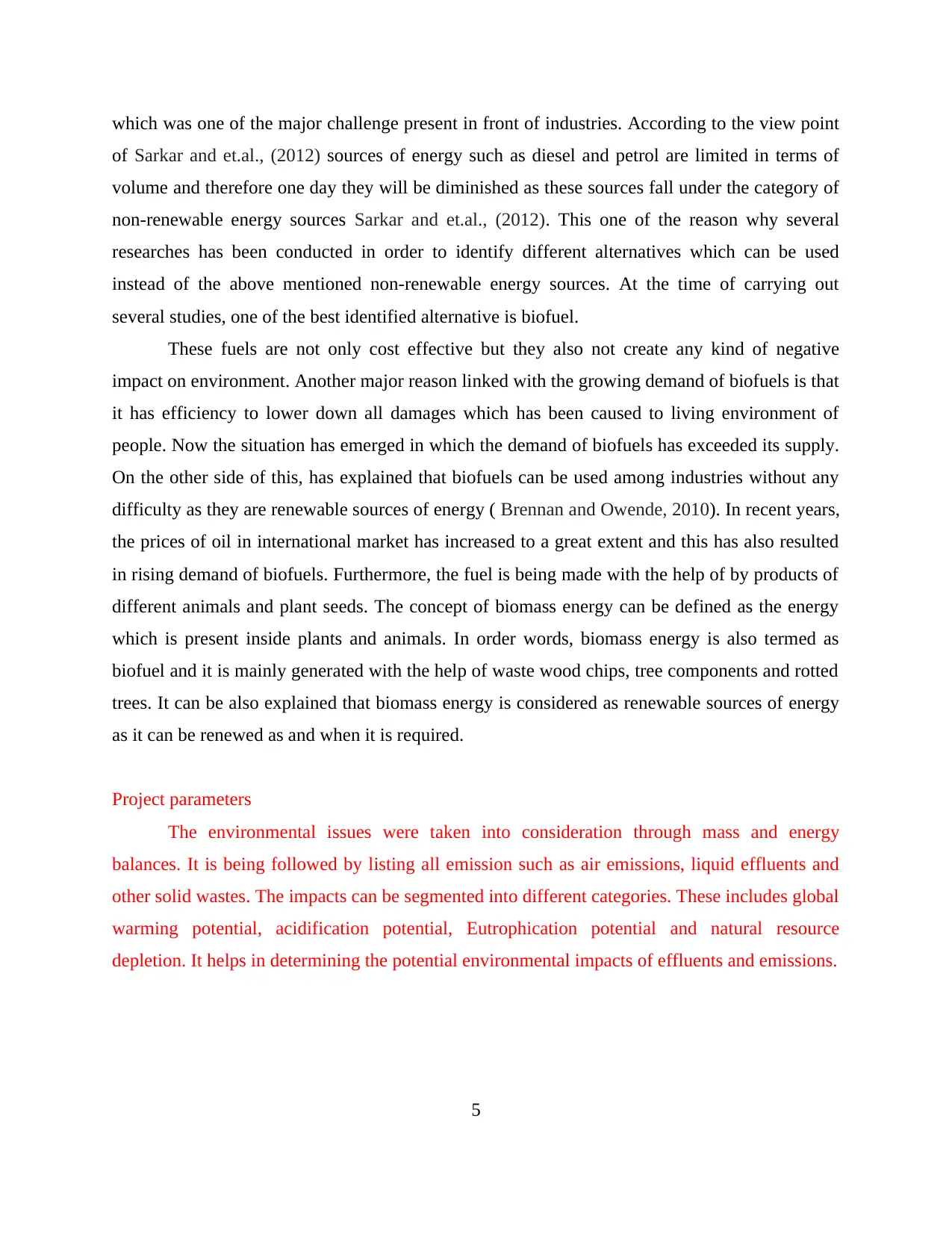
which was one of the major challenge present in front of industries. According to the view point
of Sarkar and et.al., (2012) sources of energy such as diesel and petrol are limited in terms of
volume and therefore one day they will be diminished as these sources fall under the category of
non-renewable energy sources Sarkar and et.al., (2012). This one of the reason why several
researches has been conducted in order to identify different alternatives which can be used
instead of the above mentioned non-renewable energy sources. At the time of carrying out
several studies, one of the best identified alternative is biofuel.
These fuels are not only cost effective but they also not create any kind of negative
impact on environment. Another major reason linked with the growing demand of biofuels is that
it has efficiency to lower down all damages which has been caused to living environment of
people. Now the situation has emerged in which the demand of biofuels has exceeded its supply.
On the other side of this, has explained that biofuels can be used among industries without any
difficulty as they are renewable sources of energy ( Brennan and Owende, 2010). In recent years,
the prices of oil in international market has increased to a great extent and this has also resulted
in rising demand of biofuels. Furthermore, the fuel is being made with the help of by products of
different animals and plant seeds. The concept of biomass energy can be defined as the energy
which is present inside plants and animals. In order words, biomass energy is also termed as
biofuel and it is mainly generated with the help of waste wood chips, tree components and rotted
trees. It can be also explained that biomass energy is considered as renewable sources of energy
as it can be renewed as and when it is required.
Project parameters
The environmental issues were taken into consideration through mass and energy
balances. It is being followed by listing all emission such as air emissions, liquid effluents and
other solid wastes. The impacts can be segmented into different categories. These includes global
warming potential, acidification potential, Eutrophication potential and natural resource
depletion. It helps in determining the potential environmental impacts of effluents and emissions.
5
of Sarkar and et.al., (2012) sources of energy such as diesel and petrol are limited in terms of
volume and therefore one day they will be diminished as these sources fall under the category of
non-renewable energy sources Sarkar and et.al., (2012). This one of the reason why several
researches has been conducted in order to identify different alternatives which can be used
instead of the above mentioned non-renewable energy sources. At the time of carrying out
several studies, one of the best identified alternative is biofuel.
These fuels are not only cost effective but they also not create any kind of negative
impact on environment. Another major reason linked with the growing demand of biofuels is that
it has efficiency to lower down all damages which has been caused to living environment of
people. Now the situation has emerged in which the demand of biofuels has exceeded its supply.
On the other side of this, has explained that biofuels can be used among industries without any
difficulty as they are renewable sources of energy ( Brennan and Owende, 2010). In recent years,
the prices of oil in international market has increased to a great extent and this has also resulted
in rising demand of biofuels. Furthermore, the fuel is being made with the help of by products of
different animals and plant seeds. The concept of biomass energy can be defined as the energy
which is present inside plants and animals. In order words, biomass energy is also termed as
biofuel and it is mainly generated with the help of waste wood chips, tree components and rotted
trees. It can be also explained that biomass energy is considered as renewable sources of energy
as it can be renewed as and when it is required.
Project parameters
The environmental issues were taken into consideration through mass and energy
balances. It is being followed by listing all emission such as air emissions, liquid effluents and
other solid wastes. The impacts can be segmented into different categories. These includes global
warming potential, acidification potential, Eutrophication potential and natural resource
depletion. It helps in determining the potential environmental impacts of effluents and emissions.
5
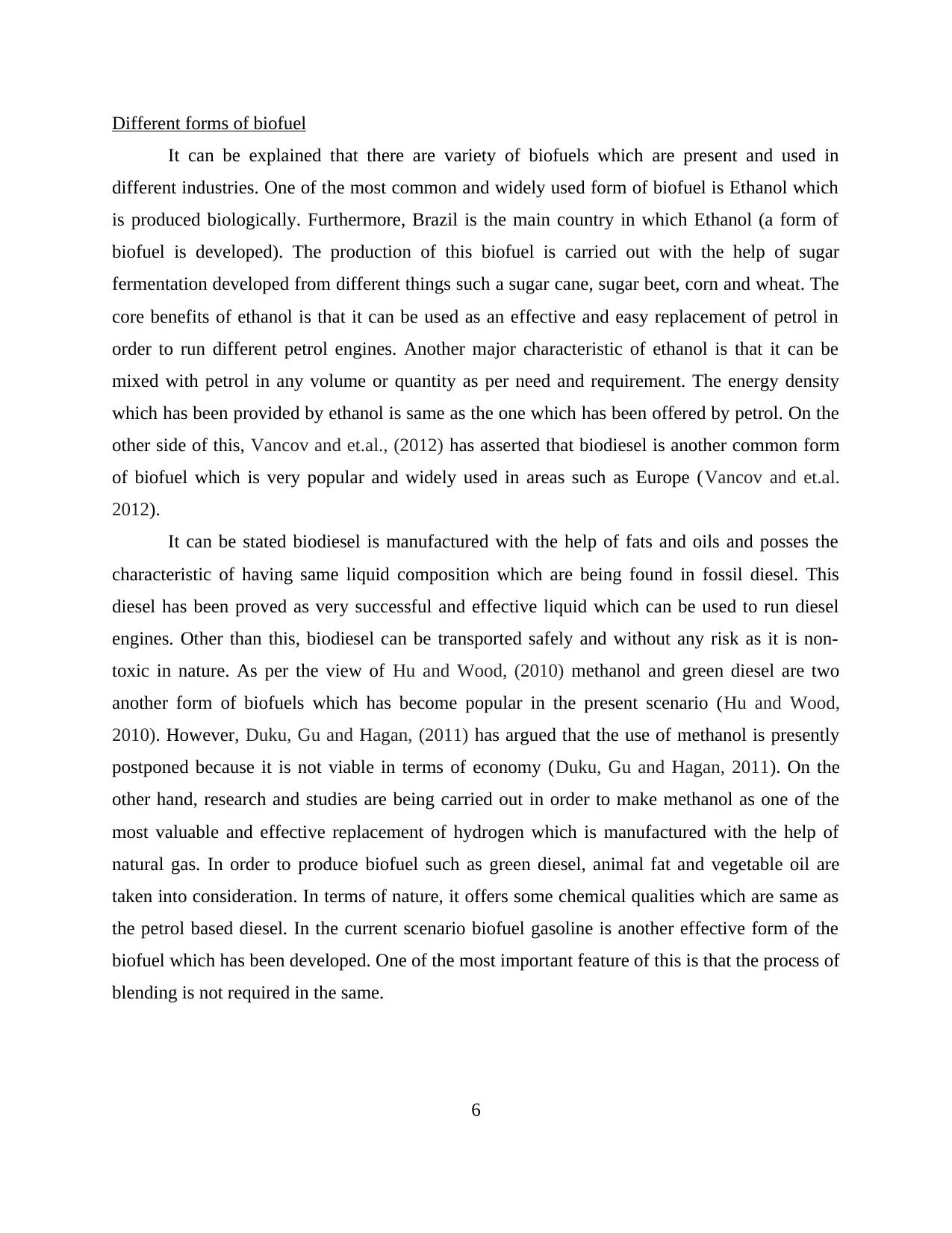
Different forms of biofuel
It can be explained that there are variety of biofuels which are present and used in
different industries. One of the most common and widely used form of biofuel is Ethanol which
is produced biologically. Furthermore, Brazil is the main country in which Ethanol (a form of
biofuel is developed). The production of this biofuel is carried out with the help of sugar
fermentation developed from different things such a sugar cane, sugar beet, corn and wheat. The
core benefits of ethanol is that it can be used as an effective and easy replacement of petrol in
order to run different petrol engines. Another major characteristic of ethanol is that it can be
mixed with petrol in any volume or quantity as per need and requirement. The energy density
which has been provided by ethanol is same as the one which has been offered by petrol. On the
other side of this, Vancov and et.al., (2012) has asserted that biodiesel is another common form
of biofuel which is very popular and widely used in areas such as Europe (Vancov and et.al.
2012).
It can be stated biodiesel is manufactured with the help of fats and oils and posses the
characteristic of having same liquid composition which are being found in fossil diesel. This
diesel has been proved as very successful and effective liquid which can be used to run diesel
engines. Other than this, biodiesel can be transported safely and without any risk as it is non-
toxic in nature. As per the view of Hu and Wood, (2010) methanol and green diesel are two
another form of biofuels which has become popular in the present scenario (Hu and Wood,
2010). However, Duku, Gu and Hagan, (2011) has argued that the use of methanol is presently
postponed because it is not viable in terms of economy (Duku, Gu and Hagan, 2011). On the
other hand, research and studies are being carried out in order to make methanol as one of the
most valuable and effective replacement of hydrogen which is manufactured with the help of
natural gas. In order to produce biofuel such as green diesel, animal fat and vegetable oil are
taken into consideration. In terms of nature, it offers some chemical qualities which are same as
the petrol based diesel. In the current scenario biofuel gasoline is another effective form of the
biofuel which has been developed. One of the most important feature of this is that the process of
blending is not required in the same.
6
It can be explained that there are variety of biofuels which are present and used in
different industries. One of the most common and widely used form of biofuel is Ethanol which
is produced biologically. Furthermore, Brazil is the main country in which Ethanol (a form of
biofuel is developed). The production of this biofuel is carried out with the help of sugar
fermentation developed from different things such a sugar cane, sugar beet, corn and wheat. The
core benefits of ethanol is that it can be used as an effective and easy replacement of petrol in
order to run different petrol engines. Another major characteristic of ethanol is that it can be
mixed with petrol in any volume or quantity as per need and requirement. The energy density
which has been provided by ethanol is same as the one which has been offered by petrol. On the
other side of this, Vancov and et.al., (2012) has asserted that biodiesel is another common form
of biofuel which is very popular and widely used in areas such as Europe (Vancov and et.al.
2012).
It can be stated biodiesel is manufactured with the help of fats and oils and posses the
characteristic of having same liquid composition which are being found in fossil diesel. This
diesel has been proved as very successful and effective liquid which can be used to run diesel
engines. Other than this, biodiesel can be transported safely and without any risk as it is non-
toxic in nature. As per the view of Hu and Wood, (2010) methanol and green diesel are two
another form of biofuels which has become popular in the present scenario (Hu and Wood,
2010). However, Duku, Gu and Hagan, (2011) has argued that the use of methanol is presently
postponed because it is not viable in terms of economy (Duku, Gu and Hagan, 2011). On the
other hand, research and studies are being carried out in order to make methanol as one of the
most valuable and effective replacement of hydrogen which is manufactured with the help of
natural gas. In order to produce biofuel such as green diesel, animal fat and vegetable oil are
taken into consideration. In terms of nature, it offers some chemical qualities which are same as
the petrol based diesel. In the current scenario biofuel gasoline is another effective form of the
biofuel which has been developed. One of the most important feature of this is that the process of
blending is not required in the same.
6
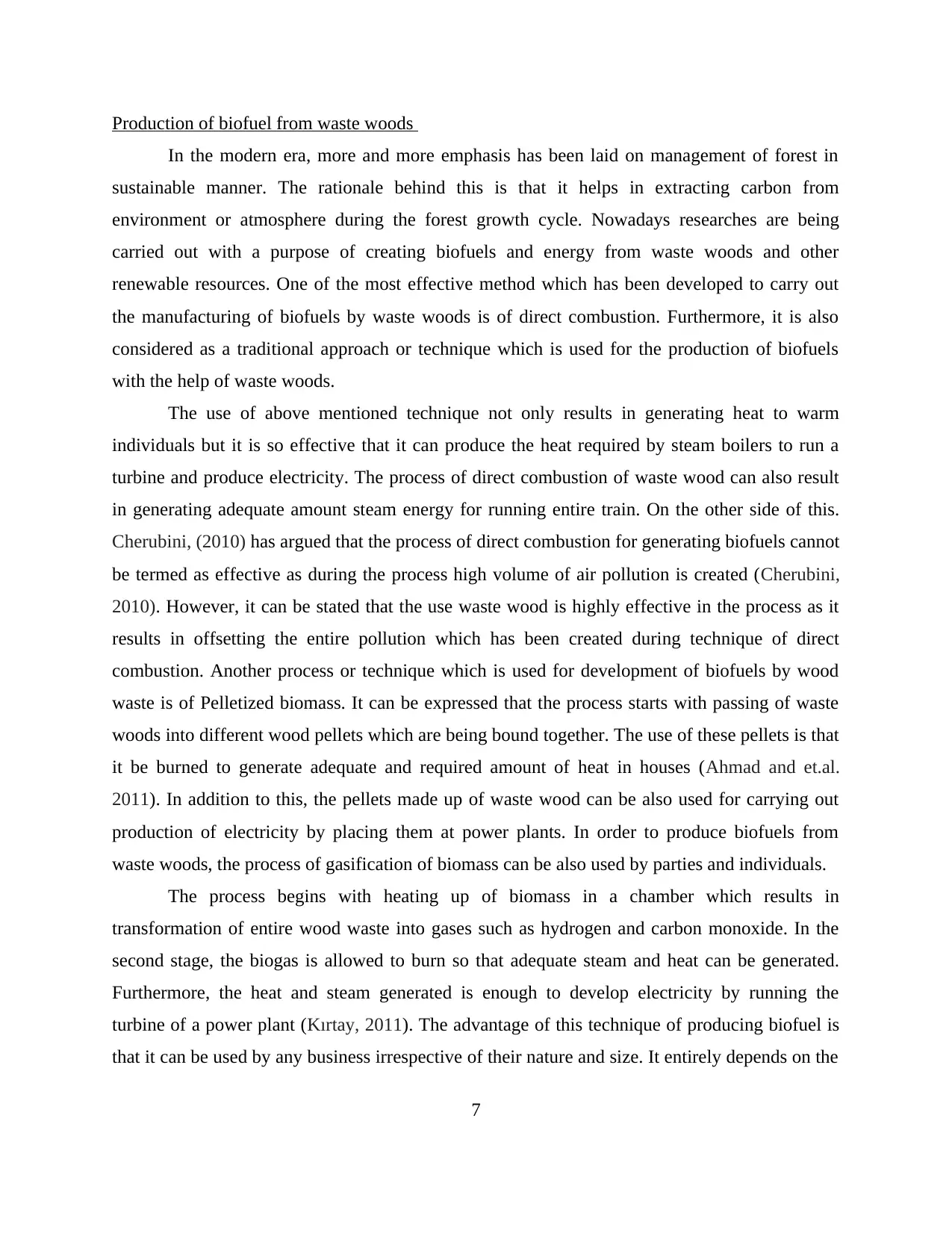
Production of biofuel from waste woods
In the modern era, more and more emphasis has been laid on management of forest in
sustainable manner. The rationale behind this is that it helps in extracting carbon from
environment or atmosphere during the forest growth cycle. Nowadays researches are being
carried out with a purpose of creating biofuels and energy from waste woods and other
renewable resources. One of the most effective method which has been developed to carry out
the manufacturing of biofuels by waste woods is of direct combustion. Furthermore, it is also
considered as a traditional approach or technique which is used for the production of biofuels
with the help of waste woods.
The use of above mentioned technique not only results in generating heat to warm
individuals but it is so effective that it can produce the heat required by steam boilers to run a
turbine and produce electricity. The process of direct combustion of waste wood can also result
in generating adequate amount steam energy for running entire train. On the other side of this.
Cherubini, (2010) has argued that the process of direct combustion for generating biofuels cannot
be termed as effective as during the process high volume of air pollution is created (Cherubini,
2010). However, it can be stated that the use waste wood is highly effective in the process as it
results in offsetting the entire pollution which has been created during technique of direct
combustion. Another process or technique which is used for development of biofuels by wood
waste is of Pelletized biomass. It can be expressed that the process starts with passing of waste
woods into different wood pellets which are being bound together. The use of these pellets is that
it be burned to generate adequate and required amount of heat in houses (Ahmad and et.al.
2011). In addition to this, the pellets made up of waste wood can be also used for carrying out
production of electricity by placing them at power plants. In order to produce biofuels from
waste woods, the process of gasification of biomass can be also used by parties and individuals.
The process begins with heating up of biomass in a chamber which results in
transformation of entire wood waste into gases such as hydrogen and carbon monoxide. In the
second stage, the biogas is allowed to burn so that adequate steam and heat can be generated.
Furthermore, the heat and steam generated is enough to develop electricity by running the
turbine of a power plant (Kırtay, 2011). The advantage of this technique of producing biofuel is
that it can be used by any business irrespective of their nature and size. It entirely depends on the
7
In the modern era, more and more emphasis has been laid on management of forest in
sustainable manner. The rationale behind this is that it helps in extracting carbon from
environment or atmosphere during the forest growth cycle. Nowadays researches are being
carried out with a purpose of creating biofuels and energy from waste woods and other
renewable resources. One of the most effective method which has been developed to carry out
the manufacturing of biofuels by waste woods is of direct combustion. Furthermore, it is also
considered as a traditional approach or technique which is used for the production of biofuels
with the help of waste woods.
The use of above mentioned technique not only results in generating heat to warm
individuals but it is so effective that it can produce the heat required by steam boilers to run a
turbine and produce electricity. The process of direct combustion of waste wood can also result
in generating adequate amount steam energy for running entire train. On the other side of this.
Cherubini, (2010) has argued that the process of direct combustion for generating biofuels cannot
be termed as effective as during the process high volume of air pollution is created (Cherubini,
2010). However, it can be stated that the use waste wood is highly effective in the process as it
results in offsetting the entire pollution which has been created during technique of direct
combustion. Another process or technique which is used for development of biofuels by wood
waste is of Pelletized biomass. It can be expressed that the process starts with passing of waste
woods into different wood pellets which are being bound together. The use of these pellets is that
it be burned to generate adequate and required amount of heat in houses (Ahmad and et.al.
2011). In addition to this, the pellets made up of waste wood can be also used for carrying out
production of electricity by placing them at power plants. In order to produce biofuels from
waste woods, the process of gasification of biomass can be also used by parties and individuals.
The process begins with heating up of biomass in a chamber which results in
transformation of entire wood waste into gases such as hydrogen and carbon monoxide. In the
second stage, the biogas is allowed to burn so that adequate steam and heat can be generated.
Furthermore, the heat and steam generated is enough to develop electricity by running the
turbine of a power plant (Kırtay, 2011). The advantage of this technique of producing biofuel is
that it can be used by any business irrespective of their nature and size. It entirely depends on the
7
Paraphrase This Document
Need a fresh take? Get an instant paraphrase of this document with our AI Paraphraser
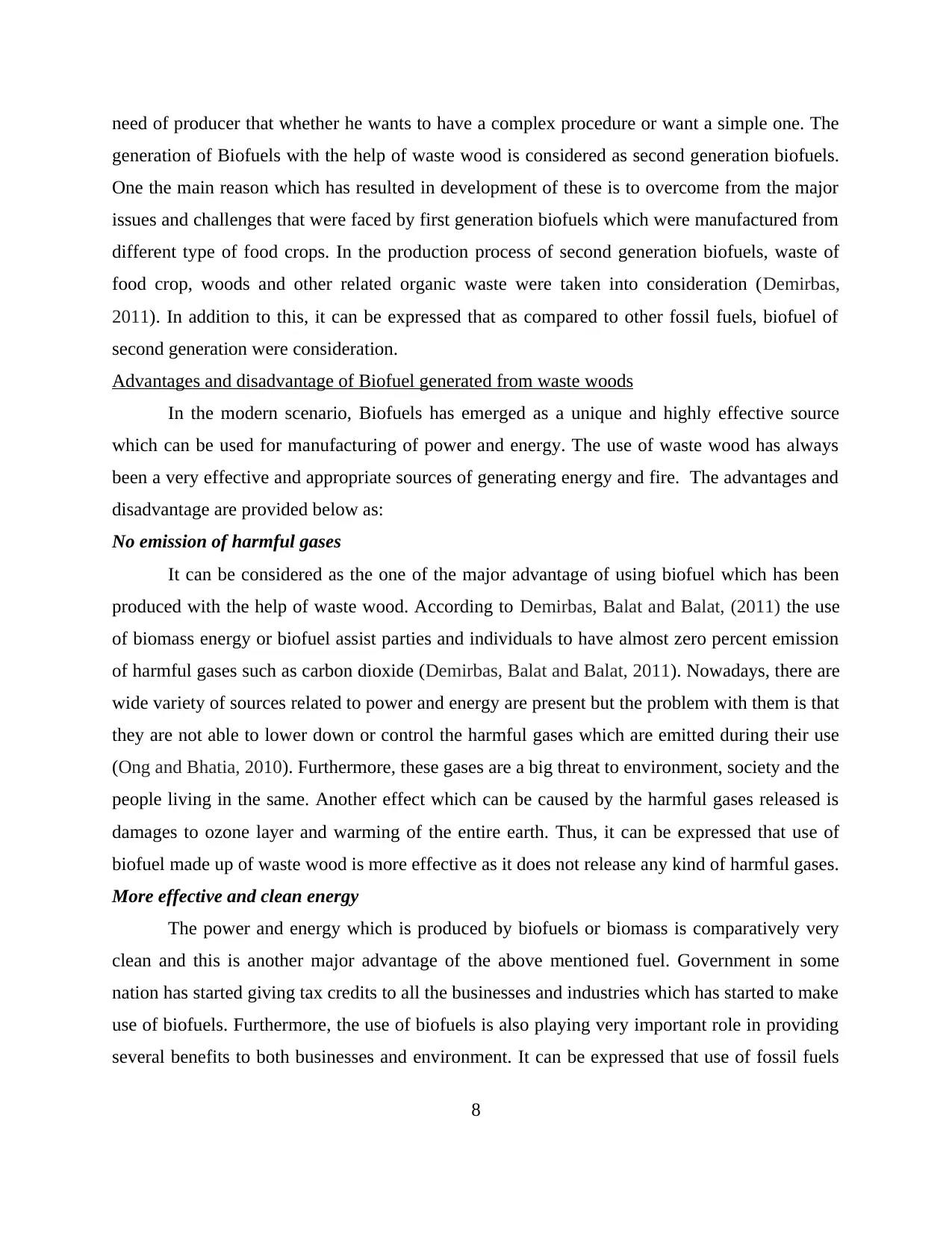
need of producer that whether he wants to have a complex procedure or want a simple one. The
generation of Biofuels with the help of waste wood is considered as second generation biofuels.
One the main reason which has resulted in development of these is to overcome from the major
issues and challenges that were faced by first generation biofuels which were manufactured from
different type of food crops. In the production process of second generation biofuels, waste of
food crop, woods and other related organic waste were taken into consideration (Demirbas,
2011). In addition to this, it can be expressed that as compared to other fossil fuels, biofuel of
second generation were consideration.
Advantages and disadvantage of Biofuel generated from waste woods
In the modern scenario, Biofuels has emerged as a unique and highly effective source
which can be used for manufacturing of power and energy. The use of waste wood has always
been a very effective and appropriate sources of generating energy and fire. The advantages and
disadvantage are provided below as:
No emission of harmful gases
It can be considered as the one of the major advantage of using biofuel which has been
produced with the help of waste wood. According to Demirbas, Balat and Balat, (2011) the use
of biomass energy or biofuel assist parties and individuals to have almost zero percent emission
of harmful gases such as carbon dioxide (Demirbas, Balat and Balat, 2011). Nowadays, there are
wide variety of sources related to power and energy are present but the problem with them is that
they are not able to lower down or control the harmful gases which are emitted during their use
(Ong and Bhatia, 2010). Furthermore, these gases are a big threat to environment, society and the
people living in the same. Another effect which can be caused by the harmful gases released is
damages to ozone layer and warming of the entire earth. Thus, it can be expressed that use of
biofuel made up of waste wood is more effective as it does not release any kind of harmful gases.
More effective and clean energy
The power and energy which is produced by biofuels or biomass is comparatively very
clean and this is another major advantage of the above mentioned fuel. Government in some
nation has started giving tax credits to all the businesses and industries which has started to make
use of biofuels. Furthermore, the use of biofuels is also playing very important role in providing
several benefits to both businesses and environment. It can be expressed that use of fossil fuels
8
generation of Biofuels with the help of waste wood is considered as second generation biofuels.
One the main reason which has resulted in development of these is to overcome from the major
issues and challenges that were faced by first generation biofuels which were manufactured from
different type of food crops. In the production process of second generation biofuels, waste of
food crop, woods and other related organic waste were taken into consideration (Demirbas,
2011). In addition to this, it can be expressed that as compared to other fossil fuels, biofuel of
second generation were consideration.
Advantages and disadvantage of Biofuel generated from waste woods
In the modern scenario, Biofuels has emerged as a unique and highly effective source
which can be used for manufacturing of power and energy. The use of waste wood has always
been a very effective and appropriate sources of generating energy and fire. The advantages and
disadvantage are provided below as:
No emission of harmful gases
It can be considered as the one of the major advantage of using biofuel which has been
produced with the help of waste wood. According to Demirbas, Balat and Balat, (2011) the use
of biomass energy or biofuel assist parties and individuals to have almost zero percent emission
of harmful gases such as carbon dioxide (Demirbas, Balat and Balat, 2011). Nowadays, there are
wide variety of sources related to power and energy are present but the problem with them is that
they are not able to lower down or control the harmful gases which are emitted during their use
(Ong and Bhatia, 2010). Furthermore, these gases are a big threat to environment, society and the
people living in the same. Another effect which can be caused by the harmful gases released is
damages to ozone layer and warming of the entire earth. Thus, it can be expressed that use of
biofuel made up of waste wood is more effective as it does not release any kind of harmful gases.
More effective and clean energy
The power and energy which is produced by biofuels or biomass is comparatively very
clean and this is another major advantage of the above mentioned fuel. Government in some
nation has started giving tax credits to all the businesses and industries which has started to make
use of biofuels. Furthermore, the use of biofuels is also playing very important role in providing
several benefits to both businesses and environment. It can be expressed that use of fossil fuels
8
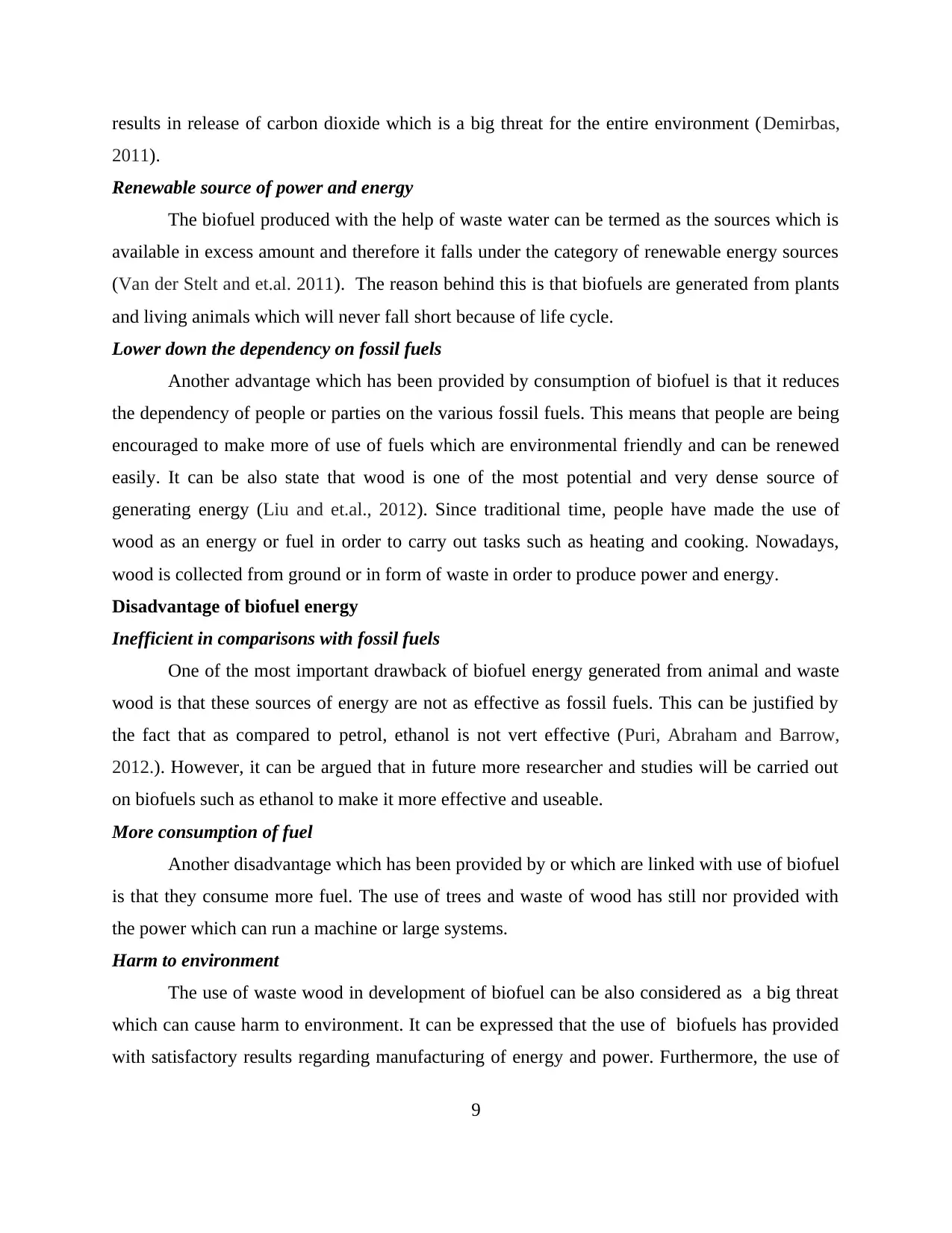
results in release of carbon dioxide which is a big threat for the entire environment (Demirbas,
2011).
Renewable source of power and energy
The biofuel produced with the help of waste water can be termed as the sources which is
available in excess amount and therefore it falls under the category of renewable energy sources
(Van der Stelt and et.al. 2011). The reason behind this is that biofuels are generated from plants
and living animals which will never fall short because of life cycle.
Lower down the dependency on fossil fuels
Another advantage which has been provided by consumption of biofuel is that it reduces
the dependency of people or parties on the various fossil fuels. This means that people are being
encouraged to make more of use of fuels which are environmental friendly and can be renewed
easily. It can be also state that wood is one of the most potential and very dense source of
generating energy (Liu and et.al., 2012). Since traditional time, people have made the use of
wood as an energy or fuel in order to carry out tasks such as heating and cooking. Nowadays,
wood is collected from ground or in form of waste in order to produce power and energy.
Disadvantage of biofuel energy
Inefficient in comparisons with fossil fuels
One of the most important drawback of biofuel energy generated from animal and waste
wood is that these sources of energy are not as effective as fossil fuels. This can be justified by
the fact that as compared to petrol, ethanol is not vert effective (Puri, Abraham and Barrow,
2012.). However, it can be argued that in future more researcher and studies will be carried out
on biofuels such as ethanol to make it more effective and useable.
More consumption of fuel
Another disadvantage which has been provided by or which are linked with use of biofuel
is that they consume more fuel. The use of trees and waste of wood has still nor provided with
the power which can run a machine or large systems.
Harm to environment
The use of waste wood in development of biofuel can be also considered as a big threat
which can cause harm to environment. It can be expressed that the use of biofuels has provided
with satisfactory results regarding manufacturing of energy and power. Furthermore, the use of
9
2011).
Renewable source of power and energy
The biofuel produced with the help of waste water can be termed as the sources which is
available in excess amount and therefore it falls under the category of renewable energy sources
(Van der Stelt and et.al. 2011). The reason behind this is that biofuels are generated from plants
and living animals which will never fall short because of life cycle.
Lower down the dependency on fossil fuels
Another advantage which has been provided by consumption of biofuel is that it reduces
the dependency of people or parties on the various fossil fuels. This means that people are being
encouraged to make more of use of fuels which are environmental friendly and can be renewed
easily. It can be also state that wood is one of the most potential and very dense source of
generating energy (Liu and et.al., 2012). Since traditional time, people have made the use of
wood as an energy or fuel in order to carry out tasks such as heating and cooking. Nowadays,
wood is collected from ground or in form of waste in order to produce power and energy.
Disadvantage of biofuel energy
Inefficient in comparisons with fossil fuels
One of the most important drawback of biofuel energy generated from animal and waste
wood is that these sources of energy are not as effective as fossil fuels. This can be justified by
the fact that as compared to petrol, ethanol is not vert effective (Puri, Abraham and Barrow,
2012.). However, it can be argued that in future more researcher and studies will be carried out
on biofuels such as ethanol to make it more effective and useable.
More consumption of fuel
Another disadvantage which has been provided by or which are linked with use of biofuel
is that they consume more fuel. The use of trees and waste of wood has still nor provided with
the power which can run a machine or large systems.
Harm to environment
The use of waste wood in development of biofuel can be also considered as a big threat
which can cause harm to environment. It can be expressed that the use of biofuels has provided
with satisfactory results regarding manufacturing of energy and power. Furthermore, the use of
9
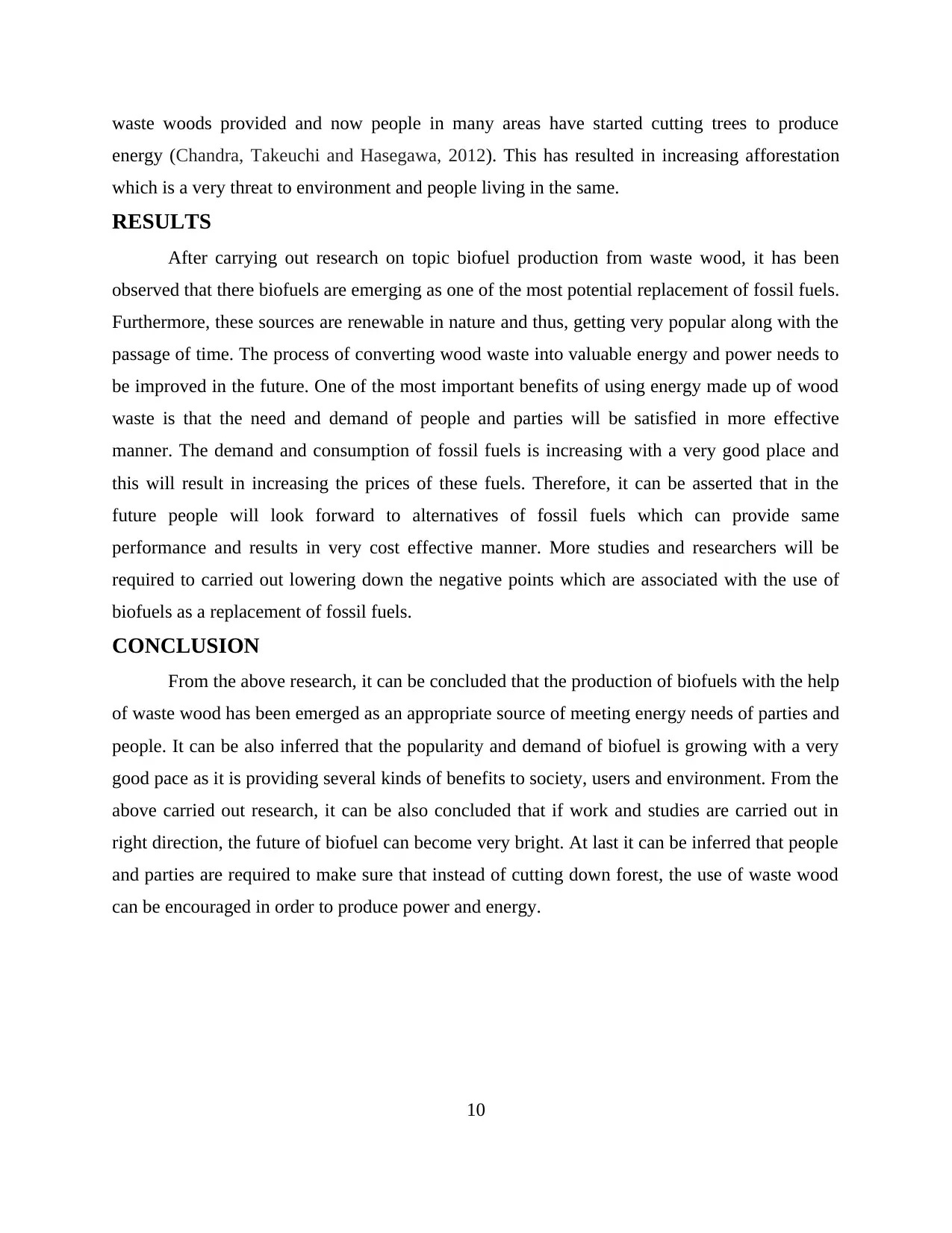
waste woods provided and now people in many areas have started cutting trees to produce
energy (Chandra, Takeuchi and Hasegawa, 2012). This has resulted in increasing afforestation
which is a very threat to environment and people living in the same.
RESULTS
After carrying out research on topic biofuel production from waste wood, it has been
observed that there biofuels are emerging as one of the most potential replacement of fossil fuels.
Furthermore, these sources are renewable in nature and thus, getting very popular along with the
passage of time. The process of converting wood waste into valuable energy and power needs to
be improved in the future. One of the most important benefits of using energy made up of wood
waste is that the need and demand of people and parties will be satisfied in more effective
manner. The demand and consumption of fossil fuels is increasing with a very good place and
this will result in increasing the prices of these fuels. Therefore, it can be asserted that in the
future people will look forward to alternatives of fossil fuels which can provide same
performance and results in very cost effective manner. More studies and researchers will be
required to carried out lowering down the negative points which are associated with the use of
biofuels as a replacement of fossil fuels.
CONCLUSION
From the above research, it can be concluded that the production of biofuels with the help
of waste wood has been emerged as an appropriate source of meeting energy needs of parties and
people. It can be also inferred that the popularity and demand of biofuel is growing with a very
good pace as it is providing several kinds of benefits to society, users and environment. From the
above carried out research, it can be also concluded that if work and studies are carried out in
right direction, the future of biofuel can become very bright. At last it can be inferred that people
and parties are required to make sure that instead of cutting down forest, the use of waste wood
can be encouraged in order to produce power and energy.
10
energy (Chandra, Takeuchi and Hasegawa, 2012). This has resulted in increasing afforestation
which is a very threat to environment and people living in the same.
RESULTS
After carrying out research on topic biofuel production from waste wood, it has been
observed that there biofuels are emerging as one of the most potential replacement of fossil fuels.
Furthermore, these sources are renewable in nature and thus, getting very popular along with the
passage of time. The process of converting wood waste into valuable energy and power needs to
be improved in the future. One of the most important benefits of using energy made up of wood
waste is that the need and demand of people and parties will be satisfied in more effective
manner. The demand and consumption of fossil fuels is increasing with a very good place and
this will result in increasing the prices of these fuels. Therefore, it can be asserted that in the
future people will look forward to alternatives of fossil fuels which can provide same
performance and results in very cost effective manner. More studies and researchers will be
required to carried out lowering down the negative points which are associated with the use of
biofuels as a replacement of fossil fuels.
CONCLUSION
From the above research, it can be concluded that the production of biofuels with the help
of waste wood has been emerged as an appropriate source of meeting energy needs of parties and
people. It can be also inferred that the popularity and demand of biofuel is growing with a very
good pace as it is providing several kinds of benefits to society, users and environment. From the
above carried out research, it can be also concluded that if work and studies are carried out in
right direction, the future of biofuel can become very bright. At last it can be inferred that people
and parties are required to make sure that instead of cutting down forest, the use of waste wood
can be encouraged in order to produce power and energy.
10
Secure Best Marks with AI Grader
Need help grading? Try our AI Grader for instant feedback on your assignments.
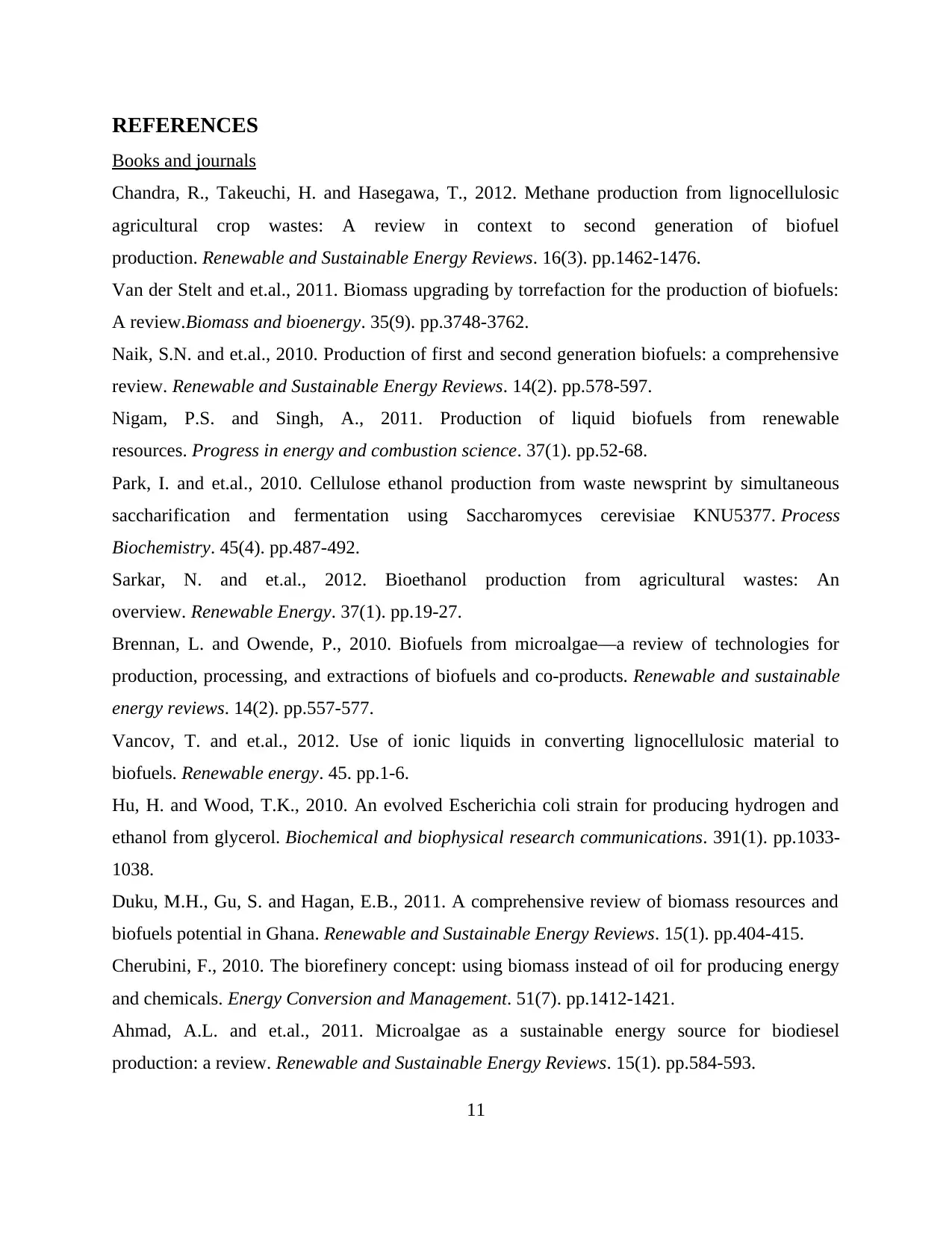
REFERENCES
Books and journals
Chandra, R., Takeuchi, H. and Hasegawa, T., 2012. Methane production from lignocellulosic
agricultural crop wastes: A review in context to second generation of biofuel
production. Renewable and Sustainable Energy Reviews. 16(3). pp.1462-1476.
Van der Stelt and et.al., 2011. Biomass upgrading by torrefaction for the production of biofuels:
A review.Biomass and bioenergy. 35(9). pp.3748-3762.
Naik, S.N. and et.al., 2010. Production of first and second generation biofuels: a comprehensive
review. Renewable and Sustainable Energy Reviews. 14(2). pp.578-597.
Nigam, P.S. and Singh, A., 2011. Production of liquid biofuels from renewable
resources. Progress in energy and combustion science. 37(1). pp.52-68.
Park, I. and et.al., 2010. Cellulose ethanol production from waste newsprint by simultaneous
saccharification and fermentation using Saccharomyces cerevisiae KNU5377. Process
Biochemistry. 45(4). pp.487-492.
Sarkar, N. and et.al., 2012. Bioethanol production from agricultural wastes: An
overview. Renewable Energy. 37(1). pp.19-27.
Brennan, L. and Owende, P., 2010. Biofuels from microalgae—a review of technologies for
production, processing, and extractions of biofuels and co-products. Renewable and sustainable
energy reviews. 14(2). pp.557-577.
Vancov, T. and et.al., 2012. Use of ionic liquids in converting lignocellulosic material to
biofuels. Renewable energy. 45. pp.1-6.
Hu, H. and Wood, T.K., 2010. An evolved Escherichia coli strain for producing hydrogen and
ethanol from glycerol. Biochemical and biophysical research communications. 391(1). pp.1033-
1038.
Duku, M.H., Gu, S. and Hagan, E.B., 2011. A comprehensive review of biomass resources and
biofuels potential in Ghana. Renewable and Sustainable Energy Reviews. 15(1). pp.404-415.
Cherubini, F., 2010. The biorefinery concept: using biomass instead of oil for producing energy
and chemicals. Energy Conversion and Management. 51(7). pp.1412-1421.
Ahmad, A.L. and et.al., 2011. Microalgae as a sustainable energy source for biodiesel
production: a review. Renewable and Sustainable Energy Reviews. 15(1). pp.584-593.
11
Books and journals
Chandra, R., Takeuchi, H. and Hasegawa, T., 2012. Methane production from lignocellulosic
agricultural crop wastes: A review in context to second generation of biofuel
production. Renewable and Sustainable Energy Reviews. 16(3). pp.1462-1476.
Van der Stelt and et.al., 2011. Biomass upgrading by torrefaction for the production of biofuels:
A review.Biomass and bioenergy. 35(9). pp.3748-3762.
Naik, S.N. and et.al., 2010. Production of first and second generation biofuels: a comprehensive
review. Renewable and Sustainable Energy Reviews. 14(2). pp.578-597.
Nigam, P.S. and Singh, A., 2011. Production of liquid biofuels from renewable
resources. Progress in energy and combustion science. 37(1). pp.52-68.
Park, I. and et.al., 2010. Cellulose ethanol production from waste newsprint by simultaneous
saccharification and fermentation using Saccharomyces cerevisiae KNU5377. Process
Biochemistry. 45(4). pp.487-492.
Sarkar, N. and et.al., 2012. Bioethanol production from agricultural wastes: An
overview. Renewable Energy. 37(1). pp.19-27.
Brennan, L. and Owende, P., 2010. Biofuels from microalgae—a review of technologies for
production, processing, and extractions of biofuels and co-products. Renewable and sustainable
energy reviews. 14(2). pp.557-577.
Vancov, T. and et.al., 2012. Use of ionic liquids in converting lignocellulosic material to
biofuels. Renewable energy. 45. pp.1-6.
Hu, H. and Wood, T.K., 2010. An evolved Escherichia coli strain for producing hydrogen and
ethanol from glycerol. Biochemical and biophysical research communications. 391(1). pp.1033-
1038.
Duku, M.H., Gu, S. and Hagan, E.B., 2011. A comprehensive review of biomass resources and
biofuels potential in Ghana. Renewable and Sustainable Energy Reviews. 15(1). pp.404-415.
Cherubini, F., 2010. The biorefinery concept: using biomass instead of oil for producing energy
and chemicals. Energy Conversion and Management. 51(7). pp.1412-1421.
Ahmad, A.L. and et.al., 2011. Microalgae as a sustainable energy source for biodiesel
production: a review. Renewable and Sustainable Energy Reviews. 15(1). pp.584-593.
11
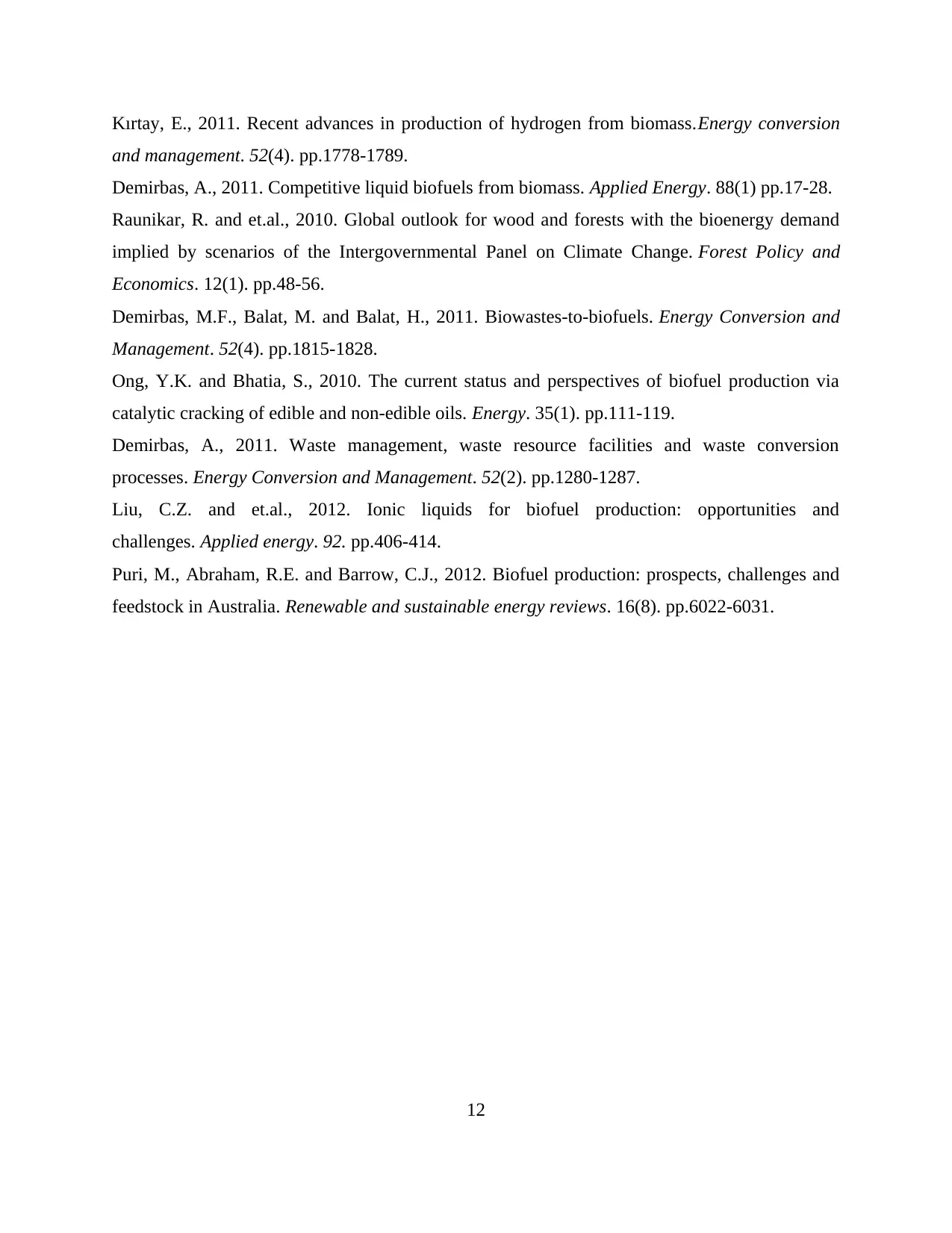
Kırtay, E., 2011. Recent advances in production of hydrogen from biomass.Energy conversion
and management. 52(4). pp.1778-1789.
Demirbas, A., 2011. Competitive liquid biofuels from biomass. Applied Energy. 88(1) pp.17-28.
Raunikar, R. and et.al., 2010. Global outlook for wood and forests with the bioenergy demand
implied by scenarios of the Intergovernmental Panel on Climate Change. Forest Policy and
Economics. 12(1). pp.48-56.
Demirbas, M.F., Balat, M. and Balat, H., 2011. Biowastes-to-biofuels. Energy Conversion and
Management. 52(4). pp.1815-1828.
Ong, Y.K. and Bhatia, S., 2010. The current status and perspectives of biofuel production via
catalytic cracking of edible and non-edible oils. Energy. 35(1). pp.111-119.
Demirbas, A., 2011. Waste management, waste resource facilities and waste conversion
processes. Energy Conversion and Management. 52(2). pp.1280-1287.
Liu, C.Z. and et.al., 2012. Ionic liquids for biofuel production: opportunities and
challenges. Applied energy. 92. pp.406-414.
Puri, M., Abraham, R.E. and Barrow, C.J., 2012. Biofuel production: prospects, challenges and
feedstock in Australia. Renewable and sustainable energy reviews. 16(8). pp.6022-6031.
12
and management. 52(4). pp.1778-1789.
Demirbas, A., 2011. Competitive liquid biofuels from biomass. Applied Energy. 88(1) pp.17-28.
Raunikar, R. and et.al., 2010. Global outlook for wood and forests with the bioenergy demand
implied by scenarios of the Intergovernmental Panel on Climate Change. Forest Policy and
Economics. 12(1). pp.48-56.
Demirbas, M.F., Balat, M. and Balat, H., 2011. Biowastes-to-biofuels. Energy Conversion and
Management. 52(4). pp.1815-1828.
Ong, Y.K. and Bhatia, S., 2010. The current status and perspectives of biofuel production via
catalytic cracking of edible and non-edible oils. Energy. 35(1). pp.111-119.
Demirbas, A., 2011. Waste management, waste resource facilities and waste conversion
processes. Energy Conversion and Management. 52(2). pp.1280-1287.
Liu, C.Z. and et.al., 2012. Ionic liquids for biofuel production: opportunities and
challenges. Applied energy. 92. pp.406-414.
Puri, M., Abraham, R.E. and Barrow, C.J., 2012. Biofuel production: prospects, challenges and
feedstock in Australia. Renewable and sustainable energy reviews. 16(8). pp.6022-6031.
12
1 out of 12
Related Documents
Your All-in-One AI-Powered Toolkit for Academic Success.
+13062052269
info@desklib.com
Available 24*7 on WhatsApp / Email
![[object Object]](/_next/static/media/star-bottom.7253800d.svg)
Unlock your academic potential
© 2024 | Zucol Services PVT LTD | All rights reserved.





